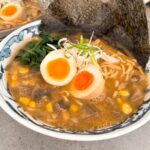Among various Japanese ramen, Miso ramen (味噌ラーメン) normally won’t be my first pick, as I find it too heavy and oily. Shio (塩ラーメン) or Tori Paitan (鶏白湯ラーメン) are more elegant and better. However, Miso ramen is the easiest to make, which doesn’t require long cooking of any bones, yet results in a rich and tasty soup broth.
Notes for Miso Ramen Broth
Once you get the concept of how to make the soup broth, you’re nearly there! No matter how unorganised you are, just throw in any toppings you like, and then literally a ramen is born (consider how the wagaxxxx called those ramens XD).
There are a few cooking notes, though:
- Swap mushrooms with minced pork for meat flavour. But if you’re like me and prefer meatless, remember to cook the mushrooms for enough time to ensure the umami is out.
- Fry the mapo sauce. It helps fully take out the sauce essence, and it definitely deepens the soup flavour.
- Dissolve the miso and sesame paste through a sieve. As mentioned in the recipe below, this can help prevent them from turning into lumps.

A Wide Range of Ramen Toppings
In Japan, ramen toppings usually consist of char siu (pork), memma (bamboo-shoot), ajitsuke tamago (marinated ramen egg), moyashi (bean sprouts), nori (seaweed), sweet corn, and even butter!
At home, I don’t bother to make char siu, and also going meat-free is not a bad idea, so I prefer the following:
- Ajitsuke Tamago (味玉, marinated ramen egg): see this recipe for details. It’s surprisingly easy to make!
- Nori (海苔, seaweed): I used this one. Reasonably priced. Cut a sheet in half and you’ll have enough for 2 bowls of ramen.
- Sweet corn: Frozen one works perfectly fine—no prep work, just throw it into the soup and enjoy!
- Negi (ねぎ, scallion): Thinly slice and soak in cold water in advance. They will curl up and be crunchy, which adds more texture contrast to your ramen.
- Boiled veg of your choice: cabbage, spinach, bean sprouts, mangetout… all are great! Forget about authenticity or whether it is grammable or not; adding more veg to our diets is always good.
Ingredients
Serves 2
- 1 ½ portion of egg noodles
For the Soup Broth
- 10 medium-sized mushroom, chopped (approx. 150 g)
- 1 tbsp sesame oil
- ½ tbsp vegetable oil
- 1 clove garlic, finely diced
- 1 round shallot, finely diced
- 1 thumb-sized ginger, finely diced
- 1 tsp mapo sauce (spicy bean sauce)
- 3 tbsp miso
- 1 tbsp pure sesame paste (or tahini)
- 1 tsp vegetable bouillon powder
- 1 tbsp sugar
- ¼ tsp white pepper
- 1 L hot water
- salt, to taste
For the Toppings
- 2 Ajitsuke Tamago (soft-boiled marinated ramen eggs)
- 5 cm each of scallion white and green
- handful of frozen corn
- handful of cabbage/spinach
- 1 sheet of nori (seaweed)
- 1 tsp crispy chilli oil (optional)


How to Make
- First, boil the egg noodles as per the packet’s instructions. Rinse under cold running water and drain. Divide into 2 bowls and drizzle in some sesame oil to prevent sticking.
- Then move on to the soup broth. Heat the sesame oil and vegetable oil in a thick-based pot; gently fry the garlic, ginger, and shallot until fragrant but not burnt. Add the mapo sauce to fry for a minute.
- Stir in the chopped mushroom and a pinch of salt; slowly cook until they are softened and release wonderful umami, about 10 minutes.
- Place the miso and sesame paste into a small sieve, half dip it into the soup, and use a chopstick or spoon to dissolve it. Otherwise, the paste can result in lumps.
- Then, add sugar and white pepper and stir well. Pour in hot boiling water, and let it simmer for 10 minutes. Have a taste and adjust.
- Now, if you prefer convenience over aesthetic pursuits, just crack in the eggs to boil for 5 minutes to achieve runny yolks. Towards the end, throw in the vegetables of your choice to cook for 3 minutes.
- At last, assembly. Pour the piping hot soup broth into the bowls with noodles; top with curled scallion and ramen eggs; drizzle in some chilli oil; stand the nori on the side just like Japanese ramen shops. Serve immediately.


